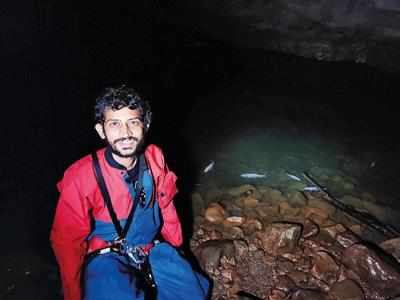
It is his passion for nature, wild life and environment which takes 31-year-old Adwait Keole into jungles, on top of mountains and deep into underground caves. Since 2016, he has been a part of ‘Caving in the Abode of the Clouds Project’ in Meghalaya where he joins a team of European cavers who visit the North-East state every year in February. Adwait, who hails from Amravati, tells TOI: “I am lucky to be one of the three Indians who are invited to join this exploring of caves. The activity has been hit by Covid so the team has not visited the country for last two years, though I, along with few others, was there in 2021 which was the International Year of Caving.”
The project began in 1992 when four cavers from European countries visited Meghalaya and discovered its caving potential. Since then the team has grown bigger. The other two Indians who are invited to join it are Vijay Chikara, a naval officer, and Sai Uplekar, from Pune.
The large expanse of limestone and humid climate of Meghalaya are conducive for cave formations. Deep under its surface exist subterranean passages, waterbodies and vast chambers. In 2018 the team made a stunning discovery of the blind fish in Krem Chympe, the fifth-longest cave in India located in Jaintia hills.
“The 40 cm long fish was called blind as it doesn’t have eyes. It was a very rare finding which showed that the cave had been untouched by human presence for thousands of years,” explains Adwait. Prime Minister Narendra Modi mentioned this discovery in his weekly broadcast Mann ki Baat.
Adwait’s interest in nature and environment goes back to his early teens when his father, a farmer in Amravati would take him along for tiger census to Melghat Tiger Reserve. “He would go for the machhan surveys. I was just 13 years old and I loved these trips,” he says.
It was on one of these trips that Adwait met another wildlife enthusiast Vishal Bansod who nurtured his interest in nature. To learn more about nature and environment and to keep his focus on the subject, Adwait studied Environmental Science at Shivaji Science College in Amravati and joined the Snow Leopard Conservatory in Ladakh after his graduation.
During the two years that he was there, Adwait came in contact with Shardul Bajikar an environment enthusiast who was also the deputy director of Sanctuary Asia Magazine. Later Adwait worked as photo librarian for the magazine in Mumbai. “It was Shardul who introduced me to caving and sent me to Meghalaya to try it out,” he says.
What do cavers look for? “Caves which we explore are naturally formed underground voids created by water cutting through the earth. What we find inside are inumerous fossils of micro and macro organisms, large amount of bat-shit, speleothems, which are a collection of structures inside the cave like stalagmites, suspended stalactites formed by thousands of years of dripping water, nests of cave pearls which are made of limestone and banded rock walls,” he says.
Caves mostly have very narrow openings. “Bats usually are a sign of existence of a cave. Sometimes villagers discover them and inform authorities,” says Adwait.
Describing speleology or study of caves as a very serious activity which requires a lot of discipline, Adwait says, “Inside a cave it is dark, claustrophobic and stinking. One has to crawl in water and slush to move around. Though it can be thrilling to enter an unknown space, it requires stamina, expertise and interest. At times we have to rappel down a vertical shaft and at other times swimming is required to approach the opening or if the cave is filled with water. It is actually a convergence of many activities as there is a fair amount of adventure and science involved.”
It is for this reason that cavers are very hesitant to have it as an adventure tourism activity. “Informed cavers are aware of the ecological significance of these formations which date back millions of years and so take care that they should not be harmed or get destroyed,” says Adwait.
Though still not a very popular activity, caving has been happening in India for the past 30 years. “Brian Daly who lives in Shillong is among the first Indians who took it up,” says Adwait. Besides caving is an expensive activity as the kit itself would cost upwards of Rs 1lakh. “It is a one-time investment and includes a suit, helmet, ropes and a mapping and tool kit comprising of compass, clinometer and GPS among other things,” he explains.
“It is not exactly a recreational activity,” says Adwait.
FacebookTwitterLinkedineMail
,